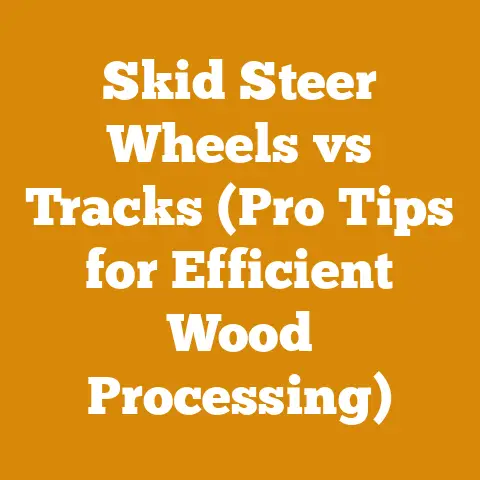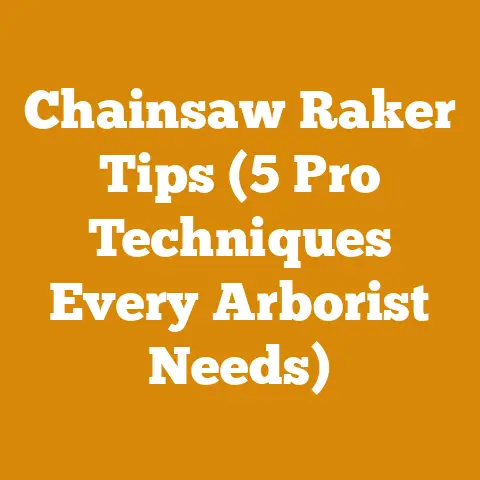Cost of Grinding Tree Stump: Pricing Tips for Arborists (Pro Insights)
Alright, let’s dive into the nitty-gritty of stump grinding costs. It’s a topic that often leaves homeowners and even some arborists scratching their heads. I’m going to pull back the curtain and share my insights, gathered from years of experience in the field, to help you understand the pricing landscape and make informed decisions.
Cost of Grinding Tree Stump: Pricing Tips for Arborists (Pro Insights)
Stump grinding isn’t just about making a yard look nicer; it’s about safety, preventing regrowth, and preparing the ground for future landscaping. But the cost? That’s where things get tricky. Unlike a haircut, there’s no standardized price list. The final bill depends on a whole host of factors, and understanding them is key to getting a fair deal.
Why Stump Grinding Costs Vary Wildly
Imagine two identical-looking tree stumps sitting side-by-side. One might cost significantly more to grind than the other. Why? Because stump grinding is more than just surface work. It’s an intricate dance with hidden roots, stubborn wood, and the unpredictable nature of the earth itself. Let’s break down the key culprits behind price fluctuations.
- Stump Size: This is the most obvious factor. A massive oak stump is going to take longer and require more powerful equipment than a small ornamental tree stump. The larger the diameter and the deeper you want the grinding to go, the higher the cost.
- Stump Location and Accessibility: Can I easily maneuver my grinder around the stump? Is it located near a fence, a building, or underground utilities? Obstacles increase the time and complexity of the job, impacting the price. A stump in the middle of a wide-open field will always be cheaper than one nestled between a house and a swimming pool.
- Tree Species and Wood Density: Not all wood is created equal. Some species, like ironwood or certain hardwoods, are incredibly dense and resistant to grinding. Softer woods, like pine, are much easier to deal with. The denser the wood, the more wear and tear on the grinder and the longer the job takes.
- Root System Complexity: What lies beneath the surface is often the biggest surprise. A stump with a sprawling, intricate root system will require more extensive grinding than one with a relatively compact root ball. Sometimes, I’ve started a job only to discover a network of roots snaking their way under sidewalks and driveways, adding hours to the project.
- Desired Grinding Depth: Do you just want the stump ground down below the surface of the lawn, or do you need it completely removed to make way for a new structure? The deeper you go, the more time and effort are required, and the higher the cost.
- Travel Time and Disposal Fees: My time and travel expenses need to be factored in, especially if I’m driving a considerable distance. Additionally, disposing of the wood chips generated during grinding can incur fees, depending on local regulations and landfill charges.
- Underground Obstacles: This is a big one! Buried rocks, concrete, or even old pipes can wreak havoc on a grinder and significantly slow down the process. Always ask about what happens if unexpected obstacles are encountered.
- Local Market Rates: Like any service, stump grinding prices are influenced by local market conditions. In areas with a high cost of living or limited competition, prices tend to be higher.
Deciphering the Pricing Models: Hourly vs. Per-Stump
The arborist industry employs two primary pricing models for stump grinding: hourly rates and per-stump pricing. Each has its advantages and disadvantages, and understanding them is crucial to making an informed decision.
Hourly Rates: Transparency and Flexibility
- How it Works: I charge a set rate per hour for my time and equipment. This model is often preferred for larger, more complex jobs where the exact time required is difficult to estimate upfront.
- Pros:
- Transparency: You see exactly what you’re paying for: my time and expertise.
- Flexibility: It allows for adjustments if unexpected obstacles are encountered or if the scope of the job changes.
- Potential Cost Savings: If the job goes faster than anticipated, you’ll pay less than a fixed price.
- Cons:
- Unpredictability: It’s difficult to know the final cost until the job is complete.
- Potential for Overcharging: Dishonest contractors could inflate the hours worked. (Always get a detailed invoice!)
- Typical Hourly Rates: Hourly rates for stump grinding can vary significantly depending on location, equipment, and experience. Based on my research and industry contacts, you can expect to pay anywhere from $150 to $300 per hour. However, I’ve seen rates as low as $100 in rural areas and as high as $400 in major metropolitan centers.
- My Experience: I typically use an hourly rate for large-scale land clearing projects or when dealing with heavily wooded areas with numerous stumps of varying sizes. It provides the flexibility to adapt to unforeseen challenges and ensures that I’m fairly compensated for my time and expertise. I always provide a detailed estimate of the expected time required and keep the client informed of any changes along the way.
Per-Stump Pricing: Simplicity and Predictability
- How it Works: I provide a fixed price for grinding each stump, regardless of the time it takes. This model is often preferred for smaller jobs with a limited number of stumps of similar size.
- Pros:
- Predictability: You know the exact cost upfront, making it easier to budget.
- Simplicity: It’s straightforward and easy to understand.
- Potential Cost Savings: If the job takes longer than anticipated, you won’t pay extra.
- Cons:
- Lack of Flexibility: It doesn’t account for unexpected obstacles or changes in the scope of the job.
- Potential for Overcharging: The contractor may inflate the price to cover potential risks.
-
Typical Per-Stump Prices: Per-stump prices are typically based on the diameter of the stump. Again, prices vary widely depending on location and other factors. Here’s a general guideline based on my experience and industry data:
- Small Stumps (under 12 inches): $80 – $150
- Medium Stumps (12-24 inches): $150 – $300
- Large Stumps (24-36 inches): $300 – $500
- Extra Large Stumps (over 36 inches): $500+ (often requires an hourly rate)
These are just averages. I’ve seen smaller stumps cost more in areas with limited access or difficult soil conditions. I strongly recommend getting multiple quotes to get a sense of the local market rates. * My Experience: I often use per-stump pricing for residential jobs with a few easily accessible stumps. It provides the client with a clear and predictable cost, and it streamlines the billing process. However, I always reserve the right to switch to an hourly rate if I encounter unexpected challenges or if the scope of the job changes significantly.
Diving Deeper: Cost Factors and Calculations
Let’s get into the weeds (pun intended!) and explore the specific cost factors that influence stump grinding prices. I’ll share some real-world examples and calculations to help you understand how these factors translate into dollars and cents.
Stump Size: The Diameter Dilemma
The diameter of the stump is the most significant factor influencing the cost of grinding. It directly affects the amount of time and effort required to complete the job.
- Measuring Stump Diameter: Measure the diameter of the stump at its widest point, at ground level. If the stump is irregular in shape, take multiple measurements and average them.
-
Calculating Surface Area: While the diameter is the primary factor, the surface area of the stump also plays a role. The larger the surface area, the more material needs to be ground away. You can calculate the approximate surface area using the following formula:
- Area = π * (diameter / 2)^2
For example, a stump with a diameter of 24 inches has a surface area of approximately 452 square inches. * Cost per Inch: Some arborists use a “cost per inch” pricing model, especially for larger stumps. This involves charging a set rate for each inch of diameter. The cost per inch can range from $5 to $20, depending on the factors mentioned earlier. * My Experience: I once had a client with a massive redwood stump that measured over 6 feet in diameter. I ended up using a combination of per-inch pricing and an hourly rate to account for the sheer size and complexity of the job. It took me two full days to grind that stump down to the desired depth!
Location and Accessibility: The Obstacle Course
The location and accessibility of the stump can significantly impact the cost of grinding. Obstacles and difficult terrain can increase the time and effort required to complete the job, and they may also necessitate the use of specialized equipment.
- Obstacles: Fences, buildings, underground utilities, and other obstacles can make it difficult to maneuver the grinder around the stump. This can increase the time required to complete the job and may also necessitate the use of smaller, more specialized equipment.
- Terrain: Steep slopes, rocky soil, and other challenging terrain can make it difficult to access the stump and operate the grinder safely and efficiently.
- Distance to Parking: The distance between the stump and the parking area can also affect the cost of grinding. The further I have to haul my equipment, the more time it takes, and the higher the cost.
- Example: I recently had a job where the stump was located in a backyard with a narrow gate and a steep set of stairs. I had to use a smaller, more portable grinder, and it took me twice as long to complete the job compared to a similar stump in an open field.
- Hidden Utilities: Always, always, ALWAYS call 811 before any digging or stump grinding project. Hitting a gas line or electrical cable is not only dangerous but can add significant costs to the project.
Tree Species and Wood Density: The Hardwood Headache
The species of tree and the density of the wood can significantly impact the cost of grinding. Harder woods require more time and effort to grind, and they can also cause more wear and tear on the equipment.
- Wood Density: Some tree species, like oak, maple, and ironwood, have very dense wood that is difficult to grind. Other species, like pine, poplar, and willow, have softer wood that is much easier to deal with.
- Resin Content: Certain tree species, like pine, contain a high amount of resin that can clog the grinder and slow down the process.
- Tooling Considerations: Grinding dense hardwoods requires specialized grinder teeth and more frequent sharpening, adding to the overall cost.
- My Experience: I once had a client with a black locust stump, which is known for its incredibly hard and durable wood. It took me almost twice as long to grind that stump compared to a similar-sized oak stump. I also had to replace the grinder teeth more frequently.
Grinding Depth: How Low Can You Go?
The desired grinding depth can significantly impact the cost of grinding. The deeper you want the grinding to go, the more time and effort are required.
- Surface Grinding: This involves grinding the stump down just below the surface of the lawn, typically 4-6 inches. This is the most common and least expensive option.
- Partial Removal: This involves grinding the stump down to a depth of 12-18 inches, which is sufficient for planting grass or shrubs.
- Complete Removal: This involves grinding the stump down to a depth of 24-36 inches, which is necessary for planting a new tree or building a structure.
- Impact on Regrowth: Grinding deeper significantly reduces the chance of the tree resprouting.
- My Experience: I always discuss the desired grinding depth with my clients before starting the job. I explain the pros and cons of each option and help them choose the best one for their needs and budget.
Disposal Fees: The Chip Conundrum
The cost of disposing of the wood chips generated during grinding can also impact the overall cost of the project.
- Volume of Chips: A large stump can generate a significant amount of wood chips, which need to be disposed of properly.
- Disposal Options:
- On-Site Disposal: The chips can be spread around the yard as mulch or used in landscaping projects. This is the most cost-effective option.
- Off-Site Disposal: The chips can be hauled away and disposed of at a landfill or composting facility. This option incurs additional fees.
- Local Regulations: Some municipalities have regulations regarding the disposal of wood chips, which may require them to be hauled away to a designated facility.
- My Experience: I always offer my clients the option of using the wood chips on-site. This is a great way to recycle the material and save money on disposal fees. However, if the client doesn’t want the chips, I haul them away to a local composting facility.
Pro Tips for Cost Optimization
Now that you understand the factors that influence stump grinding costs, let’s explore some practical tips for optimizing your budget.
- Get Multiple Quotes: Always get at least three quotes from different arborists before making a decision. This will give you a good sense of the local market rates and help you identify any outliers.
- Ask About Discounts: Some arborists offer discounts for seniors, veterans, or multiple stumps. Don’t be afraid to ask!
- Consider Off-Season Grinding: Stump grinding is often less expensive during the off-season (typically late fall and winter) when demand is lower.
- Bundle Services: If you need other tree services, such as tree removal or pruning, consider bundling them with stump grinding to get a better price.
- Clear the Area: Clear the area around the stump of any obstacles, such as rocks, debris, and vegetation. This will make it easier for the arborist to access the stump and reduce the time required to complete the job.
- Be Flexible with Scheduling: Be flexible with your scheduling and allow the arborist to schedule the job at their convenience. This can help them optimize their routes and reduce their travel expenses.
- DIY (Proceed with Caution): Renting a stump grinder and doing the job yourself can save money, but it’s not for the faint of heart. Stump grinders are powerful and dangerous machines, and it’s essential to have the proper training and experience before attempting to operate one. Also, consider the rental fees, transportation costs, and the time commitment involved.
Case Studies: Real-World Examples
Let’s take a look at some real-world case studies to illustrate how these cost factors play out in practice.
-
Case Study 1: Residential Stump Grinding
- Location: Suburban neighborhood
- Stump: Oak, 18 inches in diameter, easily accessible
- Desired Grinding Depth: 6 inches
- Disposal: On-site (wood chips used as mulch)
- Price: $250 (per-stump pricing)
-
Case Study 2: Commercial Stump Grinding
-
Location: Construction site
- Stumps: Multiple pine stumps, ranging from 12 to 36 inches in diameter, some with limited access
- Desired Grinding Depth: 12 inches
- Disposal: Off-site (wood chips hauled away)
- Price: $1,500 (hourly rate)
-
Case Study 3: Difficult Access Stump Grinding
-
Location: Backyard with a narrow gate and steep stairs
- Stump: Maple, 24 inches in diameter
- Desired Grinding Depth: 6 inches
- Disposal: On-site (wood chips used in landscaping)
- Price: $400 (per-stump pricing, adjusted for difficult access)
Choosing the right arborist is crucial to getting a fair price and a quality job. Here are some essential questions to ask before hiring someone:
- Are you licensed and insured? This is non-negotiable. Always verify that the arborist has the necessary licenses and insurance to protect yourself from liability.
- What type of equipment do you use? The type of equipment used can affect the efficiency and cost of the job.
- How much experience do you have with stump grinding? Experience matters. A seasoned arborist will be able to handle unexpected challenges and complete the job safely and efficiently.
- What is your pricing structure? Do you charge an hourly rate or per stump? Make sure you understand the pricing structure and get a written estimate.
- What is included in the price? Does the price include disposal fees, travel expenses, and other charges?
- What happens if you encounter unexpected obstacles? How will the price be adjusted if you encounter buried rocks, underground utilities, or other unexpected obstacles?
- What is your cleanup process? How will you clean up the area after the job is complete?
- Can you provide references? Ask for references from previous clients and check them thoroughly.
The Future of Stump Grinding: Innovations and Trends
The stump grinding industry is constantly evolving, with new technologies and techniques emerging to improve efficiency and reduce costs.
- Remote-Controlled Grinders: These grinders can be operated remotely, allowing access to difficult or dangerous locations.
- Hydraulic Grinders: These grinders are more powerful and efficient than traditional grinders, allowing them to tackle even the toughest stumps.
- Bio-Stump Removal: This involves using natural enzymes to decompose the stump over time, eliminating the need for grinding. However, this process can take several months or even years.
- GPS and Mapping Technologies: These technologies can be used to map and track stumps, improving efficiency and accuracy.
Actionable Takeaways and Next Steps
- Assess Your Needs: Determine the size, location, and species of the stump, as well as the desired grinding depth and disposal method.
- Get Multiple Quotes: Contact at least three arborists and get written estimates.
- Compare Prices and Services: Compare the prices and services offered by different arborists, and choose the one that best meets your needs and budget.
- Verify Credentials: Check the arborist’s licenses, insurance, and references.
- Schedule the Job: Schedule the job at a convenient time and ensure that the area around the stump is clear of any obstacles.
- Monitor the Progress: Monitor the progress of the job and ask questions if you have any concerns.
- Provide Feedback: Provide feedback to the arborist after the job is complete to help them improve their services.
Final Thoughts: Stumped No More!
Stump grinding costs can seem daunting, but with a little knowledge and preparation, you can navigate the pricing landscape and get a fair deal. Remember to assess your needs, get multiple quotes, verify credentials, and ask questions. By following these tips, you can transform that unsightly stump into a smooth, usable space.






